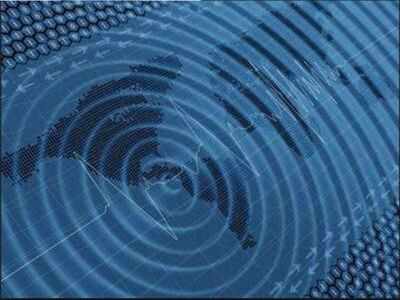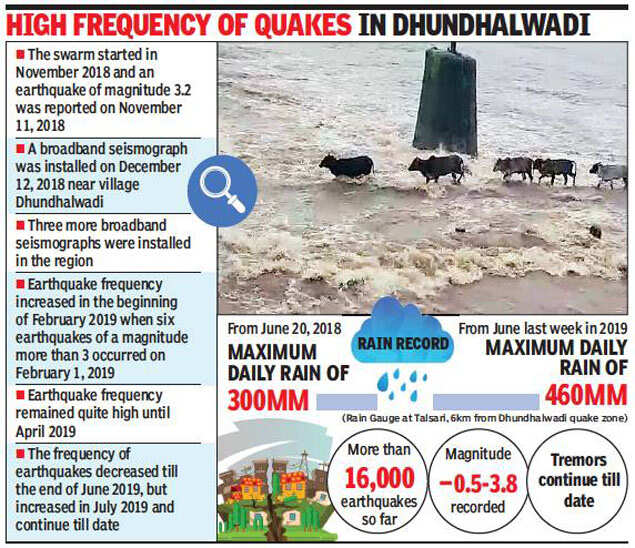
PUNE: Rain could be responsible for the consecutive, low intensity, earthquakes in Palghar near Mumbai, scientists from National Centre for Seismology, India Meteorological Department and CSIR-National Geophysical Research Institute, Hyderabad and other institutes have found.
So far, more than 16,000 earthquakes of magnitude −0.5 to 3.8 have been recorded. They continue even now.

After heavy rain in this region, copious water seeped into the earth and its movement could be causing tremors, the scientists said. Palghar district is the northernmost part of Konkan which experiences heavy rain.
There is fear that the smaller earthquakes in this region could be a prelude to an imminent, bigger and more catastrophic earthquake. The research that attributes the tremors to rain allays such fears.
In November 2018, a low magnitude earthquake swarm, a sequence of seismic events in a local area in a short time, with a rumbling sound occurred close to Dhundhalwadi villages in Palghar.
The swarm started after the monsoon season and was on the decline in May–June 2019, but the frequency increased during the monsoon in June 2019.
The enhanced earthquake activity suggests that the swarm was probably triggered by the monsoon.
“The satellite analysis revealed shallow below-surface process of precipitated rain water movement, leading to the collapse of underground earth cavities in the village. Therefore, the earthquakes in Palghar may not be linked with the tectonic plate movement, but with rain,” Vineet K Gahalaut, scientist, CSIR-National Geophysical Research Institute, Hyderabad said.
Scientists have been monitoring the tremor, locating them accurately, finding them in a 30km area surrounding Dhundhalwadi village at a shallow depth of up to 6km with very clustered epicentres, Gahalaut said.
“It is most likely that these earthquakes are caused by the percolation of rainfall water at a depth and the collapse of underground cavities due to this gushing flow. Such occurrences may not lead to a bigger earthquake,” he added.
Two methods were adopted in the study, including earthquake monitoring and interferometric synthetic aperture radar. Five seismographs were installed around the region of earthquakes.
Other institutes involved in the study included National Centre for Seismology, New Delhi, ISRO-Space Applications Centre Ahmedabad, Institute of Seismological Research, Ahmedabad. The study was recently published in the international journal Tectonophysics.
So far, more than 16,000 earthquakes of magnitude −0.5 to 3.8 have been recorded. They continue even now.

After heavy rain in this region, copious water seeped into the earth and its movement could be causing tremors, the scientists said. Palghar district is the northernmost part of Konkan which experiences heavy rain.
There is fear that the smaller earthquakes in this region could be a prelude to an imminent, bigger and more catastrophic earthquake. The research that attributes the tremors to rain allays such fears.
In November 2018, a low magnitude earthquake swarm, a sequence of seismic events in a local area in a short time, with a rumbling sound occurred close to Dhundhalwadi villages in Palghar.
The swarm started after the monsoon season and was on the decline in May–June 2019, but the frequency increased during the monsoon in June 2019.
The enhanced earthquake activity suggests that the swarm was probably triggered by the monsoon.
“The satellite analysis revealed shallow below-surface process of precipitated rain water movement, leading to the collapse of underground earth cavities in the village. Therefore, the earthquakes in Palghar may not be linked with the tectonic plate movement, but with rain,” Vineet K Gahalaut, scientist, CSIR-National Geophysical Research Institute, Hyderabad said.
Scientists have been monitoring the tremor, locating them accurately, finding them in a 30km area surrounding Dhundhalwadi village at a shallow depth of up to 6km with very clustered epicentres, Gahalaut said.
“It is most likely that these earthquakes are caused by the percolation of rainfall water at a depth and the collapse of underground cavities due to this gushing flow. Such occurrences may not lead to a bigger earthquake,” he added.
Two methods were adopted in the study, including earthquake monitoring and interferometric synthetic aperture radar. Five seismographs were installed around the region of earthquakes.
Other institutes involved in the study included National Centre for Seismology, New Delhi, ISRO-Space Applications Centre Ahmedabad, Institute of Seismological Research, Ahmedabad. The study was recently published in the international journal Tectonophysics.
Trending Topics
LATEST VIDEOS
City
 Delhi riots: Video of day 2 violence shows mob attacking cops with sticks, stones
Delhi riots: Video of day 2 violence shows mob attacking cops with sticks, stones  Bharuch: Man caught smuggling liquor in scooter’s footboard, video goes viral
Bharuch: Man caught smuggling liquor in scooter’s footboard, video goes viral  International Women's Day: 14-year-old girl becomes DSP 'for a day' in Maharashtra's Buldhana district
International Women's Day: 14-year-old girl becomes DSP 'for a day' in Maharashtra's Buldhana district  Nirbhaya case: 4 convicts to hang on March 20, says Delhi court
Nirbhaya case: 4 convicts to hang on March 20, says Delhi court
More from TOI
Navbharat Times
Featured Today in Travel
Get the app



